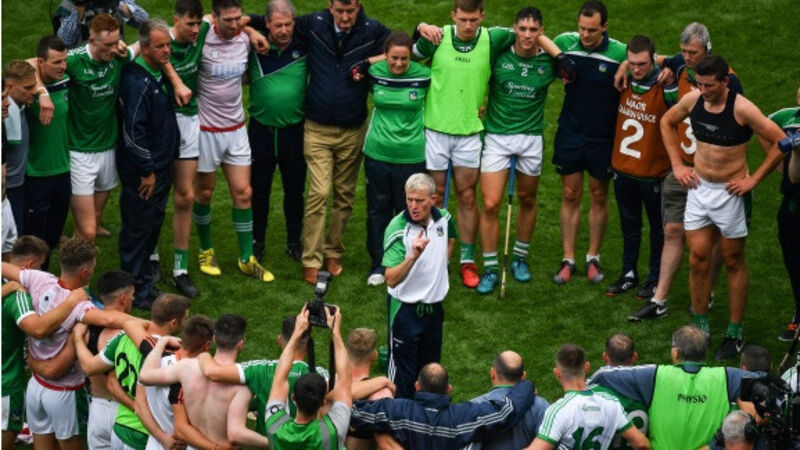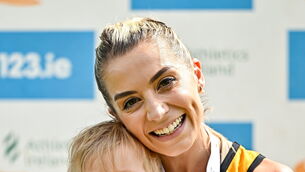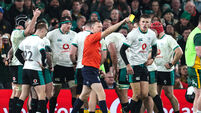Why Limerick may have to lose one to win one

When John Kiely walked into the Croke Park press room after his team’s epic semi-final win over Cork and immediately declared he’d withdraw all co-operation with the media if any member of it attempted to contact any member of his group in the lead up to the final outside the official press day, it created something of an uneasy atmosphere in the room and among the ranks.
His tone seemed oddly unnecessary, even aggressive.
Steady, John, who or what do you take us for? As if any of us in this day and age bother with bothering the now cossetted species that is the modern inter-county player before any championship game, let alone an All Ireland final?
Any hack ruffled or offended by Kiely’s pre-emptive strike should soon have recognised they weren’t Kiely’s intended audience.
The media were merely the medium. Kiely’s message was for the Limerick public: We’ve got this. There’ll be no hype this time. This time it’s different.
And it was warmly received by that public, unaware as they were of the nuances of modern GAA media relations.
Good man, John, putting those media boys in their place. You’re on it and we’re in on it. This time it’s different.
By willing to momentarily upset media relations, Kiely was simultaneously engaging in public relations. He described the Limerick fans as having been “fantastic”, both in how they had urged on and raised the team throughout that match and indeed assisted them throughout the whole summer. Instead of asking the Limerick public to back off and continue to give the team “great space”, he said he knew they would act appropriately.
In neuro-linguistic programming, just one of many fields the team’s performance coach Caroline Currid has studied, they call it ‘embedding commands’.
Instead of ordering or asking someone to behave as you or they wish, implicitly infer — embed — that the desired behaviour will happen, as a matter of course.
“They lifted the roof [against Cork],” Kiely said. “And I know they will do that again in the future and we thank them for that.”
Instead of lecturing the Limerick public, Kiely has praised and gently guided it.
At times Limerick have come across in some quarters to be nearly taking it to an extreme, the safeguards and protocols they’ve put in place to manage the hype, but they know what they’re doing.
Their message — let the supporters enjoy the occasion and let the players and management prepare for the match — is one straight from Mickey Harte’s manual of 2003, someone Currid would team up with and win an All-Ireland in 2008.
She’s also worked with other All-Ireland winning set-ups in the Tipperary hurlers and Dublin footballers while she’d also have learned quite a lot about how NOT to do things from her two-year involvement with Ger Cunningham’s ill-fated Dublin hurlers before teaming up with Kiely and Limerick 20 months ago. In her game and in this Limerick set-up which is deeply versed in the lessons of the Limerick experience, they talk a lot about process, routines.
“We have our own objectives, our own goals, our own work, we have our own routines and our own patterns,” Kiely would say at that same press conference.
“We don’t have open sessions for example, the lads go to work every day.”
And that practice, those routines and patterns would stay pretty much the same for the All-Ireland final, just as they would have been in place for the first-round game against Tipperary.
When Limerick last played an All-Ireland final back in 2007, their press day was held in probably the most salubrious setting any GAA team press day has ever been staged — Adare Manor; we can still see Richie Bennis lapping it up, holding court, in the place the ever-accommodating JP McManus laid on. It goes without saying, when Limerick played Tipperary in the first round of that year’s championship, it wouldn’t have been held in Adare Manor. Currid and Kiely’s thinking would be: Well, why the difference? There’s enough different about an All-Ireland final as it is.
This year press day was held in the Castletroy Park Hotel, an event so normalised that one journalist in attendance remarked that not only could you be in Limerick without knowing it was the team’s All-Ireland final press day but you could have been in the Castletroy Park Hotel itself and not known it was on.
There were other mistakes from 2007 that Limerick will not be repeating. Andrew O’Shaughnessy, an All-Star that year, has spoken in recent weeks about how 11 years ago players were unveiling the opening of several businesses “trying to make hay while the sun shines”.
Kiely’s perceived preemptive hostile strike against the media would likewise have sent out the message that such exploitation and naivety would not be recurring on his beat.
In truth, no team these days is so naive going into an All-Ireland final. The following year Waterford were nearly worse, over-celebrating qualification and therefore poorly-preparing for their first September appearance in 45 years, but since then most sides appearing in an All-Ireland senior final have done themselves justice.
In 2009, a young Tipperary team, aided by Currid’s mental preparation, pushed Kilkenny to the limit, before losing by five points. Since then the average winning margin in an All-Ireland hurling final has been 4.4 points.
In football for the last 10 years it has been 2.1 points a game, with never more than four points separating the sides, commeasurable with how better teams are now prepared.
You will still get the odd team affected and overwhelmed by a provincial final appearance, such as Fermanagh and Down the past two years in Ulster. But in general any team that has been steely enough to win through to an All-Ireland final in this day and age is also sufficiently mentally tough enough to not be significantly affected by the build-up or occasion.
There is hardly likely to be a deviation from trend on Sunday. In 2015 Galway wavered when the heat came on, not having enough confidence and trust in everything from their game plan, fitness, management, themselves.
During Micheál Donoghue’s tenure such doubts have been erased. Limerick similarly believe they have every box ticked. Joe O’Connor has them primed and prepared to be the one team athletically and physically able to match Galway. Paul Kinnerk’s training sessions and methods in their eyes are as advanced as Francis Forde’s, Kiely’s steady hand as assured as Donoghue’s.
The occasion won’t beat Limerick, yet it is not a contradiction to still surmise that Galway may well do on the grounds that they have more experience of the occasion.
If you leave aside the great outlier that was 2013 when a Clare side that hadn’t even contested a Munster final had the benefit of playing and edging a Cork team that had only one starter who had previously played in a senior All-Ireland final, a side doesn’t just bolt from the middle of the peleton to suddenly stand at the apex of the podium. The more experienced side, especially of the big day, tends to shade it; any semblance of a lack of hunger on their part would have tended to have been exposed a round or two earlier.
When the younger side does edge it, like the Tipp hurlers of 2010 and the Dublin footballers of 2011 that Currid both worked with, it tends to be from having experienced both the confidence and pain of being so near but so far the previous season; both those two sides sampled that bittersweet sensation when they seriously challenged but were ultimately pipped by more worldly Kilkenny and Cork sides that charged for home once Henry Shefflin and Donncha O’Connor icily nailed their respective penalties.
As much as Currid has helped teams cheat experience and gain from her own and Kiely has tried to stave his side off repeating the experiences and mistakes of past Limerick teams, nothing beats being there before.
Even a side as well as prepared as this may have to lose one to win one.











